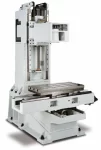Five-axis CNC technology has revolutionized the energy equipment manufacturing industry with its innovative application. This advanced technology allows for precise and efficient machining of complex parts, leading to improved product quality, reduced production time, and increased productivity. In this article, we will explore the various applications of five-axis CNC technology in the energy equipment manufacturing sector.
1. Enhanced Precision and Accuracy
One of the key advantages of five-axis CNC technology is its ability to achieve higher precision and accuracy in machining operations. Traditional three-axis machines limit the range of motion, making it challenging to produce intricate and complex parts. However, with the addition of two more axes, the machine can rotate and tilt the workpiece, allowing for greater flexibility in cutting angles and orientations. This enhanced precision ensures that critical components in energy equipment, such as turbine blades or impellers, are manufactured with utmost accuracy, resulting in improved performance and reliability.
2. Reduction in Production Time
The integration of five-axis CNC technology in the energy equipment manufacturing process significantly reduces the overall production time. With the ability to perform multiple operations on a single machine setup, manufacturers can eliminate the need for manual repositioning or tool changes. This streamlines the manufacturing process and minimizes downtime, ultimately increasing productivity. Additionally, the advanced software and programming capabilities of five-axis CNC machines enable efficient toolpath optimization, further reducing cycle times. As a result, energy equipment manufacturers can meet tight deadlines and deliver products to the market faster than ever before.
3. Complex Geometry Machining
The complex geometry of many energy equipment components poses significant challenges for conventional machining techniques. Five-axis CNC technology overcomes these obstacles by allowing simultaneous cutting in multiple directions and angles. This capability enables manufacturers to produce intricate shapes, contours, and undercuts with ease. Whether it’s manufacturing complex turbine blades or specialized pump impellers, the versatility of five-axis CNC machines ensures precise replication of intricate designs. The ability to efficiently machine complex geometries enhances the overall performance and efficiency of energy equipment, contributing to the industry’s continuous innovation.
4. Improved Efficiency in Prototyping
Five-axis CNC technology has greatly improved the efficiency of prototyping in energy equipment manufacturing. Traditionally, creating prototypes involved multiple iterations and manual adjustments to achieve the desired design. Five-axis CNC machines eliminate much of this manual labor by offering faster and more accurate prototyping capabilities. With the ability to quickly transform CAD models into physical parts, manufacturers can test and validate their designs more efficiently. This accelerated prototyping process reduces lead times and allows for faster product iterations, leading to improved design optimization and ultimately, better-quality energy equipment.
Conclusion
The innovative application of five-axis CNC technology in the energy equipment manufacturing sector has revolutionized the industry. By offering enhanced precision, reduced production time, the ability to machine complex geometries, and improved prototyping efficiency, this advanced machining technology has become a cornerstone of the energy equipment manufacturing process. As the demand for energy equipment continues to grow, the adoption of five-axis CNC technology will undoubtedly play a crucial role in meeting the industry’s evolving needs for higher quality, faster production, and greater innovation.
.webp)
